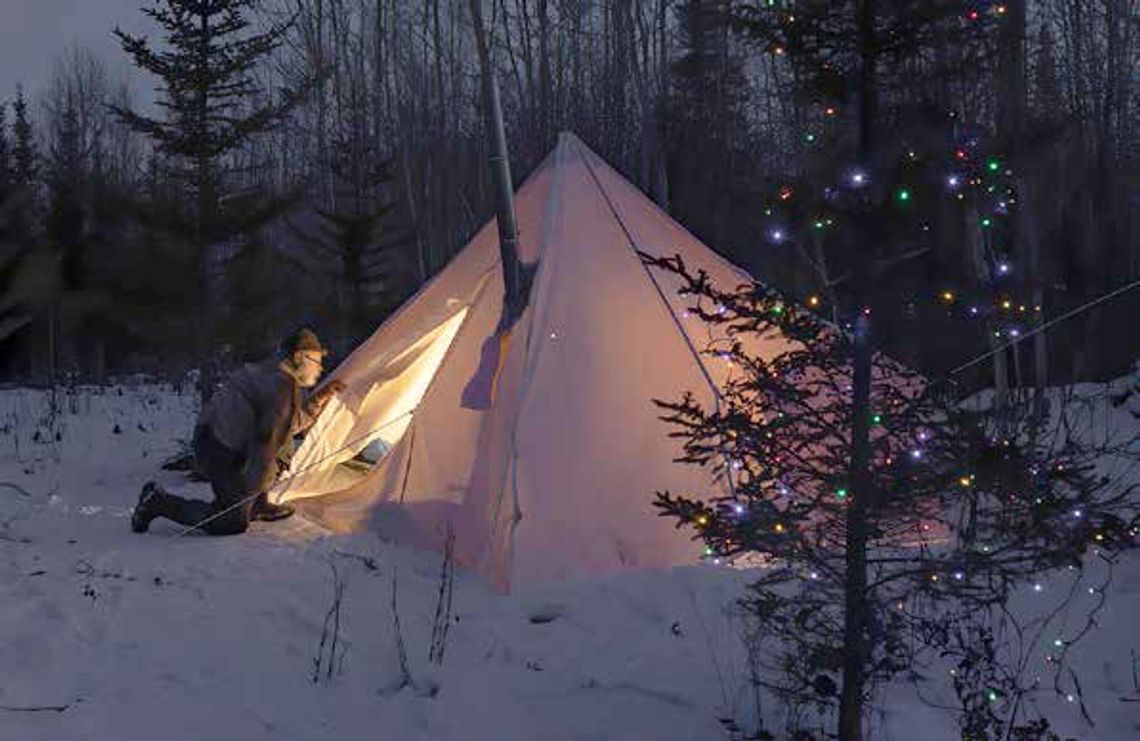Chapter 21 - My Evolution into Winter Camping
I grew up in northern Minnesota. Feet of snow, temperatures falling out the bottom of thermometers, numb fingers, feet – not inches of ice covering the lakes, stinging cheeks and white spots on the tip of my nose. I have thrived my whole life in these conditions to fish, hunt, ski, go sledding without giving them much of a second thought. That is until 1979 when I was asked to go winter camping with my buddy Tom.
Though I would go camping several times during the summer, I had never been winter camping. My first thought was “why would anyone want to do that”! I had no gear that could be considered “winter” gear for spending a night in the bush. Yes, theoretically I guess it was possible but again, why? Tom had an answer that made sense. “I’ve heard that Thomas Lake is filled with twenty-pound lake trout, and I want to get me one of them”! Of course, it was obvious that Thomas Lake was much too far to make as a day trip, so spending a couple of nights battling the elements was necessary to make that happen.
Tom assured me he had done it a couple of times. He talked me into it. That said, he didn’t know much more about winter camping than I did. Tom is one tough dude, and it was mostly his “sisu” that guided him through his - and our - early trips.
There was a STEEP learning curve that took place in those early years. We learned almost everything the hard way. After our first trip we modified for our second. More modifications took place after our second, our third and our fourth. Eventually we became proficient enough to improve our chances of surviving an outing year by year. Let me expound.
Our first trip we were “cold camping” which meant that we brought a 4-man Eureka Timberlane tent. Our intention was to use skis as our primary source of travel and all I had at the time was a single pair of narrow touring skis. Tom has only ever had one pair of skis, and they are army surplus wood skis with cable bindings. We both had frame packs on our backs. Into my pack I had stuffed TWO sleeping bags (how cold was it going to get?), a pair of Sorels, a Thermorest sleeping pad, a clothes bag with an extra wool sweater, extra long johns, two pair of wool socks, choppers with extra liners, a heavy winter coat, two t-shirts and an extra wool hat. We brought three days’ worth of food, no freeze-dried, but frozen. A steel grate for cooking on. Ski wax and scraper. Two, liter bottles of water. Of course, we were fishing so two tip-ups, a short winter fishing rod, tackle and plenty of frozen ciscos had to be included. On top were my Michigan snowshoes – just in case. Tom’s pack was similar except that he substituted the tent for the steel grate. It was almost 12 miles into Thomas Lake, but we got lost and didn’t make it in. The trip was miserable.
Our post-trip debriefings mostly included what it would take to make the next trip easier. Our second trip would be into Burke Lake. We had learned a few lessons, but not many. We had a much better sense of what clothes to bring, what food to bring and other items that we wouldn’t need. The grate was the first item to go along with my second sleeping bag. I had purchased a pair of back-country skis, and we decided the snowshoes really weren’t necessary. Backpacks still had the day, however, and Tom brought his frame pack, but I decided a number 4 Duluth pack would serve me better. It was worse. We had four people on the next trip and could lessen our loads by spreading some of the community gear out among us. It was a cold stretch in January that year, but we survived and actually caught some fish!
Our third trip provided the first major breakthrough. The backpack thing just wasn’t working. We had seen that arctic explorers used sleds instead of packs (they used sled dogs as well but that was far beyond where we were willing to go) and that some short-term travelers were using something called a “pulk”. Not wanting to spend the $700 to buy a commercial pull-behind, we endeavored to build our own out of plastic sleds made for sliding down hills, plastic conduit, some rope and army web belts. We were very pleased with our progress. Sleds were relatively easy to pull, could hold a lot of gear and took a lot of strain off the shoulders and hips. A bonus was that going up and down hills while skiing was a lot easier and safer. It was also made for an enjoyable trip.
The next few years saw us making more and more modifications in gear and experimenting with sled design. It became obvious early on that a short sled stacked high with gear had some major drawbacks. They tipped over easily, and it
was necessary to unhook the belt and ski or walk back to the sled to right it. Over time the sleds became longer, and the weight distributed laterally instead of vertically. Replacing bags, various tarp configurations would cover our gear. Belts were upgraded and on my latest sled, a shoulder harness was added that spreads the pull over a much greater area. We also looked to lighten the loads a bit by bringing just tarps to sleep under or no shelter at all – as did Ross Petersen on an early journey. One of those trips to Knife Lake, sleeping under a tarp with a fire built between us and a rock wall led us to our next big modification.
Sleeping in a warm tent came to us relatively late. Getting up to put on cold boots, bumping the tent ceiling and getting rained on by hoar frost were downsides to cold camping in a tent. I guess the idea of carrying the weight of a stove, not to mention a tent designed to not melt if it came too close to a stove pipe, was foreign to our thinking. Having sleds to pull more weight helped the next transition. Our first attempts encouraged us. Having a warm place to go ate up many hours that previously had been spent constrained to a mummy bag for twelve hours a day. In January, it gets dark and cold by 4:30 in the afternoon. Fishing is done for the day and even a big fire can’t keep you warm when it’s forty below. Crawling into your bag inside a tent is the only way to keep from getting chilled. Even with flashlights and reading or playing cards, by 6:00 the day is done. Daylight doesn’t come until almost 8:00 the next morning. That’s a long time to be cooped up in a tent. Enter the heated tent with a Coleman lantern! All of a sudden, the night is shortened by being comfortable in a bit larger tent with enough light to play cards until nine or ten! It’s also a great place to take a break during the middle of the day where you can take a nap in comfort.
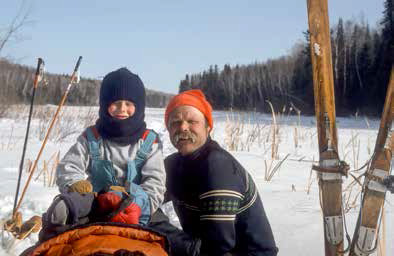
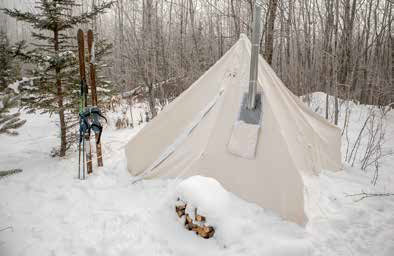
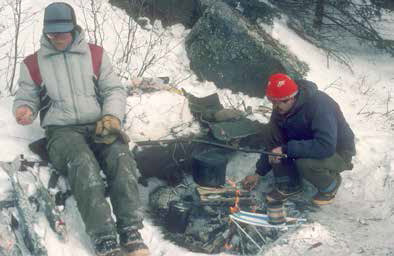
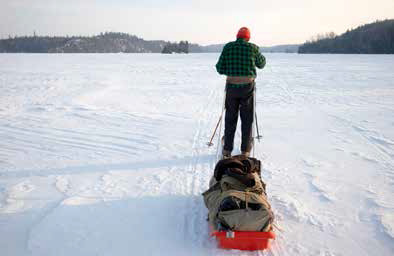
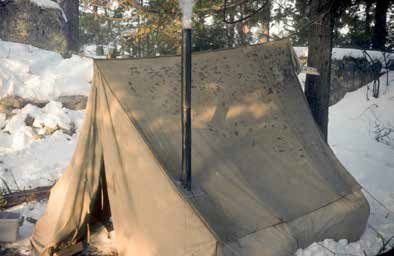
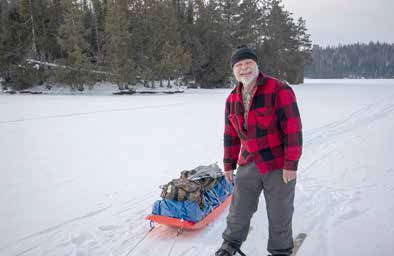
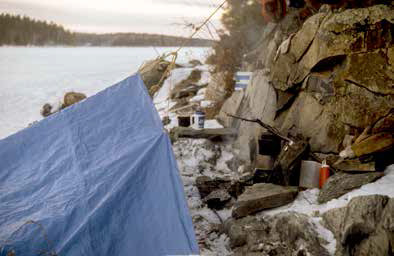
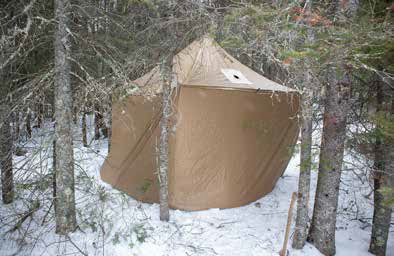
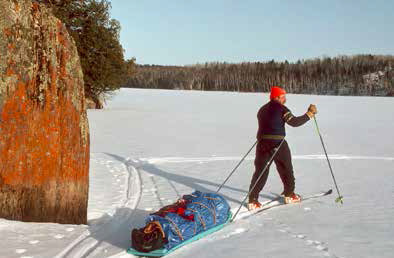
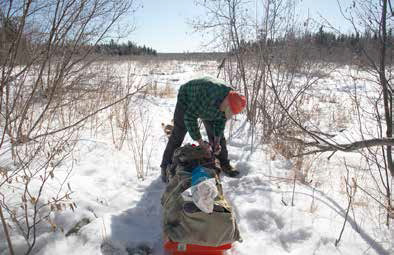

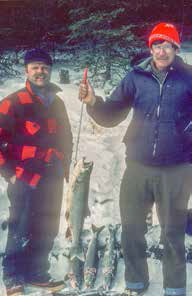
Our first attempts were pretty crude. Our tents tended to be modified summer tents made of canvas. They worked but were heavy. Some stoves were old fish house stoves or homemade affairs constructed from old five-gallon grease cans. Don’t get me wrong – these were pleasant trips and much easier to look forward to! We tried to cut down tent weight by sewing together tarps or trying to put heat resistant flashing into the roofs of nylon tents. Tom came across a seamstress who was willing to design and sew a nylon tent made to his specifications and give plenty of headroom and space for gear as well as flashing positioned to keep the tent from melting. His current tent weighs eight pounds and with the stove adds a total of about twelve pounds to the sled. Of course, there are commercial products out there for thousands of dollars that can do the same, but we find some satisfaction in making our own.
Every trip we modify just a bit but have the process down pretty well. It might be a new parka, the latest in fishing gear, an updated cuisine that strikes our fancy. The process has come a long way since our first disaster back in 1979. I have tried several different skis over the years. From backcountry Karhu’s with metal edges, to wooden army surplus skis with Berwin bindings like Tom’s to my latest, HOK skis. They might be my last. At our age we have talked about getting freighted back to Thomas or Knife or Basswood by dogsled but find getting ourselves in and out of the backcountry part of the challenge that we like. I just got back from six days on Lac LaCroix and Tom got home a couple of days ago from hiking a 65-mile loop in Bob Marshall Wilderness in western Montana. I guess as long as we can still do these kinds of trips, we’ll continue winter camping as we have always done – on our own terms.
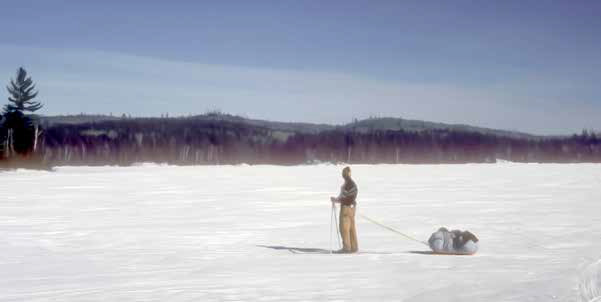
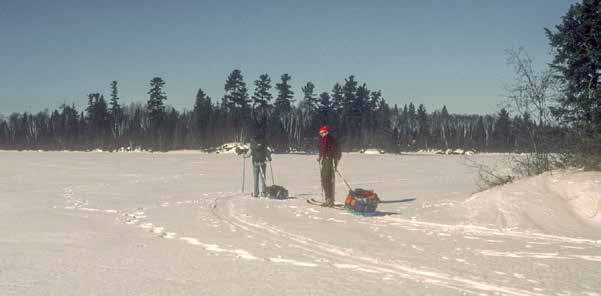
.jpg)
